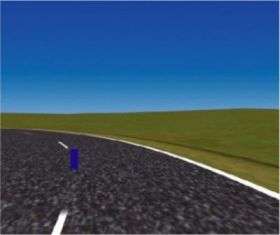Directing a driver's gaze results in smoother steering

A study recently published in ARVO's online Journal of Vision may inform the next generation of in-car driving assistance systems. New research finds that when drivers fix their gaze on specific targets placed strategically along a curve, their steering is smoother and more stable than it is in normal conditions.
Typically, drivers gaze along a curve as they negotiate it, but they also look at other parts of the road, the dashboard, traffic signs and oncoming vehicles. A new study finds that when drivers fix their gaze on specific targets placed strategically along a curve, their steering is smoother and more stable than it is in normal conditions.
The study, "Driving around bends with manipulated eye-steering coordination" was recently published in the online Journal of Vision (www.journalofvision.org/8/11/10), a peer-reviewed publication from the Association for Research in Vision and Ophthalmology.
"This work may be relevant for the design of visual driving assistance systems," explains author Franck Mars, PhD, of the Institut de Recherche en Communications et Cybernétique de Nantes (IRCCyN), Nantes, France.
"Indeed, the next generation of head-up displays in cars will offer the opportunity for a driving aid that offers a wide field of view and highlights key features in the visual scene," adds Dr. Mars. "This study may help answer the question of which visual cues should be made available in such displays."
The experiment included 13 drivers who drove a simulator vehicle while looking at a large screen displaying a roadway featuring a series of curves. The focus and direction of each driver's gaze was monitored and recorded.
In a series of control and test trials, researchers had drivers steer around the simulated course while fixing their gaze on a small blue bar.
The blue bar represents the tangent point — the point where, from the driver's viewpoint, the inside edge line seems to begin to change direction as it outlines the curve.
The results revealed that the ?xation targets helped the driver improve the stability of steering control.
This study suggests that indicating a point along the oncoming road in the vicinity of the tangent point may be a simple and efficient way to make vehicle control easier.
Source: Association for Research in Vision and Ophthalmology



















